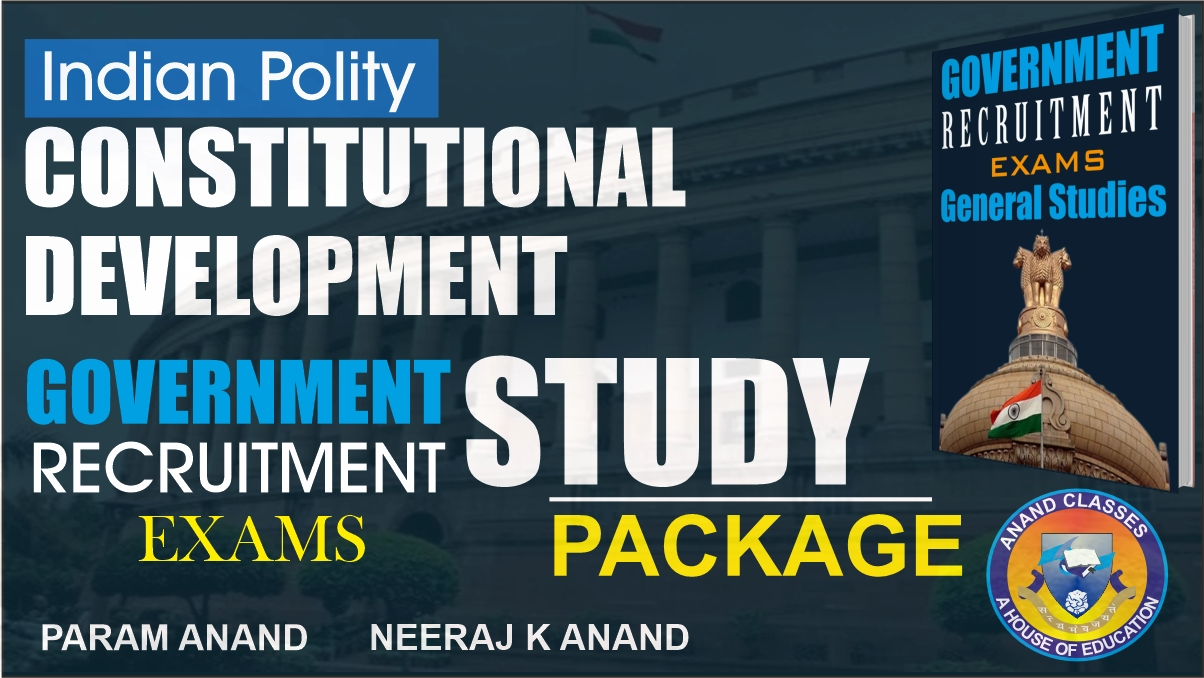📘 For UPSC Civil Services Examination (CSE), Engineering Services Examination (ESE), CAPF (Central Armed Police Forces), Indian Forest Service (IFS), NDA, CDS, UPSC, AFCAT, RRB, IBPS-PO, SSC, KVS, CLAT Exams
📖 Study Material | Learning Resources | Indian Polity Notes
Written by Neeraj Anand | Published by Anand Technical Publishers
🔗 Read Full Notes on Anand Classes
📌 FAQs – Phases of the Constituent Assembly & Its Functions
Here are some frequently asked questions (FAQs) regarding the phases of the Constituent Assembly of India and its other functions. These are helpful for UPSC, SSC, State PSC, and other competitive exams.
Q1: What were the three phases of the Constituent Assembly of India?
🔹 The Constituent Assembly of India functioned in three phases:
1️⃣ First Phase (6th September 1946 – 14th August 1947): It worked under the limitations of the Cabinet Mission Plan before India became independent.
2️⃣ Second Phase (15th August 1947 – 26th November 1949): It became a sovereign body and a provisional Parliament after India’s independence.
3️⃣ Third Phase (27th November 1949 – March 1952): It functioned as a provisional Parliament until the first general elections were held.
📌 Related Posts:
National Symbols of India|NDA,CDS,UPSC,AFCAT,RRB,IBPS-PO,SSC,KVS,CLAT Exams Study Material
|
Constituent Assembly | NDA, CDS, UPSC, AFCAT, RRB, IBPS-PO, SSC, KVS, CLAT
|
Preamble of Indian Constitution|NDA,CDS,UPSC,AFCAT,RRB,IBPS-PO,SSC,KVS,CLAT,MCQs,Notes
|
Citizenship Amendment Act 2015 | NDA, CDS, UPSC, AFCAT, RRB, IBPS-PO, SSC, KVS, CLAT Notes
|
Overseas Citizen of India (OCI) | NDA,CDS,UPSC,AFCAT,RRB,IBPS-PO,SSC,KVS,CLAT Exams Notes
Q2: What was the role of the Constituent Assembly in the first phase (1946-1947)?
🔹 During this phase, the Constituent Assembly was limited by the Cabinet Mission Plan and had:
✅ 389 members (296 from British India & 93 from Princely States).
✅ The first meeting was held on December 9, 1946.
✅ Dr. Sachidanand Sinha was the temporary president, and later Dr. Rajendra Prasad was elected as the permanent president.
✅ The Muslim League boycotted the Assembly, demanding a separate Pakistan.
Q3: How did the Constituent Assembly function in its second phase (1947-1949)?
🔹 After independence on 15th August 1947, the Constituent Assembly became a sovereign body and worked on:
✅ Framing the Constitution of India.
✅ Drafting Committee was appointed on 29th August 1947, chaired by Dr. B.R. Ambedkar.
✅ On 26th November 1949, the Constitution was adopted.
Q4: What happened in the third phase of the Constituent Assembly (1949-1952)?
🔹 After adopting the Constitution on 26th November 1949, the Constituent Assembly functioned as a Provisional Parliament until the first general elections in 1952.
✅ It debated laws and passed resolutions until a newly elected Parliament took charge in 1952.
📌 Other Functions of the Constituent Assembly
Q5: When was the National Flag of India adopted?
🔹 The Constituent Assembly adopted the National Flag of India on 22nd July 1947.
Q6: What decision did the Constituent Assembly take regarding India’s membership in the Commonwealth?
🔹 In May 1949, the Constituent Assembly ratified India’s membership in the Commonwealth of Nations, allowing India to remain a republic while being part of the British Commonwealth.
Q7: When were the National Anthem and National Song adopted?
🔹 The Constituent Assembly adopted the National Anthem (“Jana Gana Mana”) and National Song (“Vande Mataram”) on 24th January 1950.
Q8: Who was elected as the first President of India by the Constituent Assembly?
🔹 On 24th January 1950, Dr. Rajendra Prasad was elected as the first President of India by the Constituent Assembly.
Phases of Constituent Assembly
- First Phase (6th September 1946 – 14th August 1947)
- Functioned as the Constituent Assembly under the limitations of the Cabinet Mission Plan.
- Worked on drafting the Indian Constitution before independence.
- Second Phase (15th August 1947 – 26th November 1949)
- The Constituent Assembly played a crucial role in framing the Constitution of India and acted in different capacities over three distinct phases. Understanding these phases is vital for aspirants preparing for NDA, CDS, UPSC, AFCAT, RRB, IBPS-PO, SSC, KVS, and CLAT exams.
- Third Phase (27th November 1949 – March 1952)
- Continued as a provisional Parliament until the first general elections were held in 1952.
Other Functions Performed by the Constituent Assembly
- Adoption of National Flag: On 22nd July 1947, the Assembly adopted the Indian National Flag.
- Commonwealth Membership: Ratified India’s membership of the Commonwealth in May 1949.
- Adoption of National Anthem & Song: Adopted Jana Gana Mana as the National Anthem and Vande Mataram as the National Song on 24th January 1950.
- Election of First President: Dr. Rajendra Prasad was elected as the first President of India on 24th January 1950.
📝 Quiz: Phases of the Constituent Assembly & Its Functions
1. Who first proposed the idea of a Constituent Assembly for India?
(A) M. N. Roy(B) Mahatma Gandhi
(C) Dr. B. R. Ambedkar
(D) Jawaharlal Nehru
2. When did the first phase of the Constituent Assembly start?
(A) 15th August 1947(B) 6th September 1946
(C) 26th January 1950
(D) 9th December 1946
3. How many members were in the Constituent Assembly initially?
(A) 299(B) 250
(C) 389
(D) 400
4. Which political party boycotted the Constituent Assembly?
(A) Indian National Congress(B) Muslim League
(C) Forward Bloc
(D) Hindu Mahasabha
5. Who was elected as the permanent President of the Constituent Assembly?
(A) Dr. Rajendra Prasad(B) Dr. Sachidanand Sinha
(C) Jawaharlal Nehru
(D) Dr. B. R. Ambedkar
📌 Conclusion
📌 The Constituent Assembly played a key role in drafting the Indian Constitution and performed important national functions like adopting the National Flag, National Anthem, and electing the first President of India.
✅ Understanding these phases and contributions is important for exams like UPSC, SSC, Banking, and other government job exams! 🚀
🔗 Need more study material? Visit: Anand Classes
Importance for Government Exam Aspirants
Understanding the phases of the Constituent Assembly and its key decisions is essential for competitive exams like NDA, CDS, UPSC, AFCAT, RRB, IBPS-PO, SSC, KVS, and CLAT. Questions related to the formation of the Constitution, key dates, and the role of the Constituent Assembly frequently appear in these exams.
Stay prepared with these crucial points to excel in your exam!




